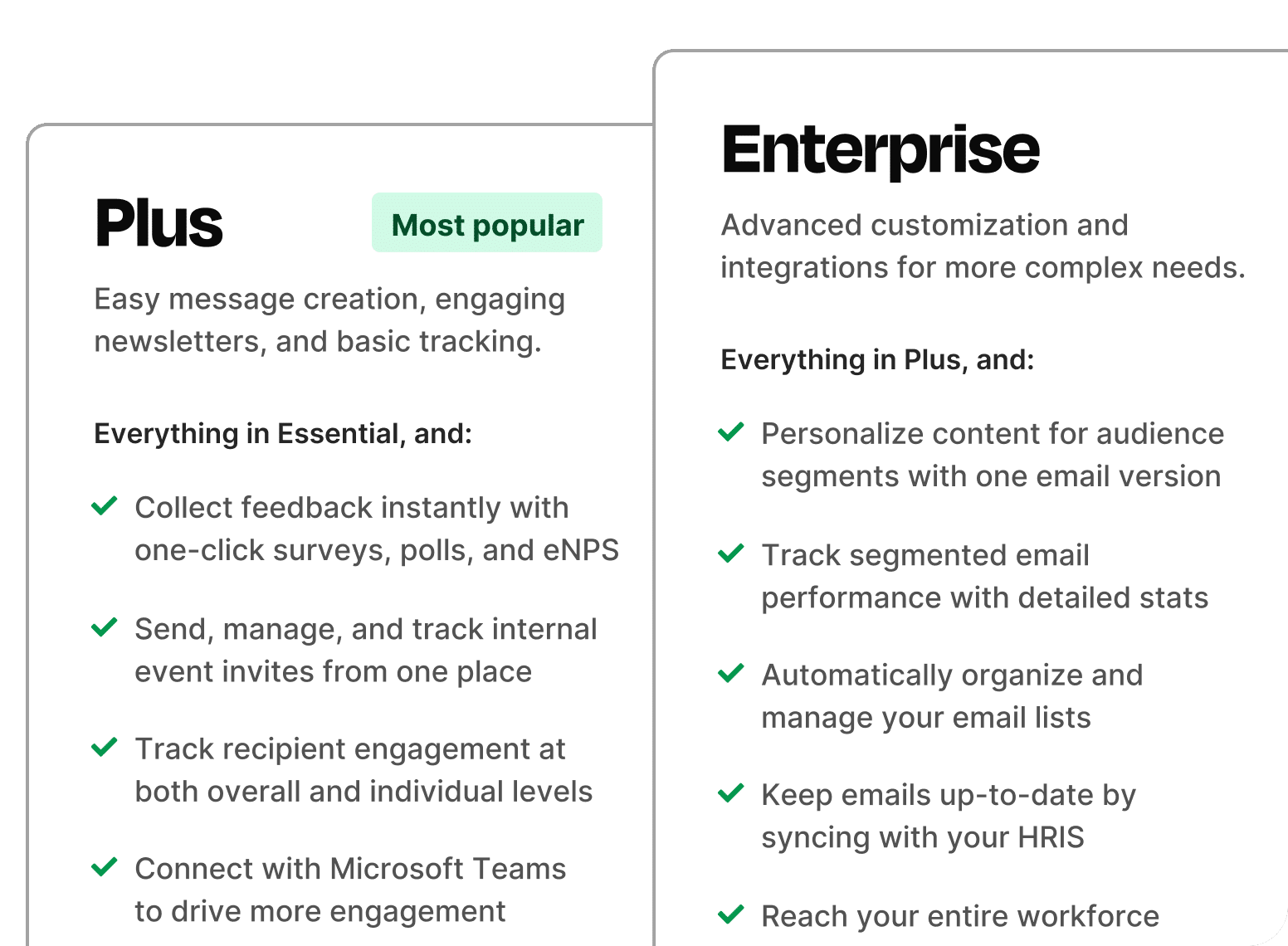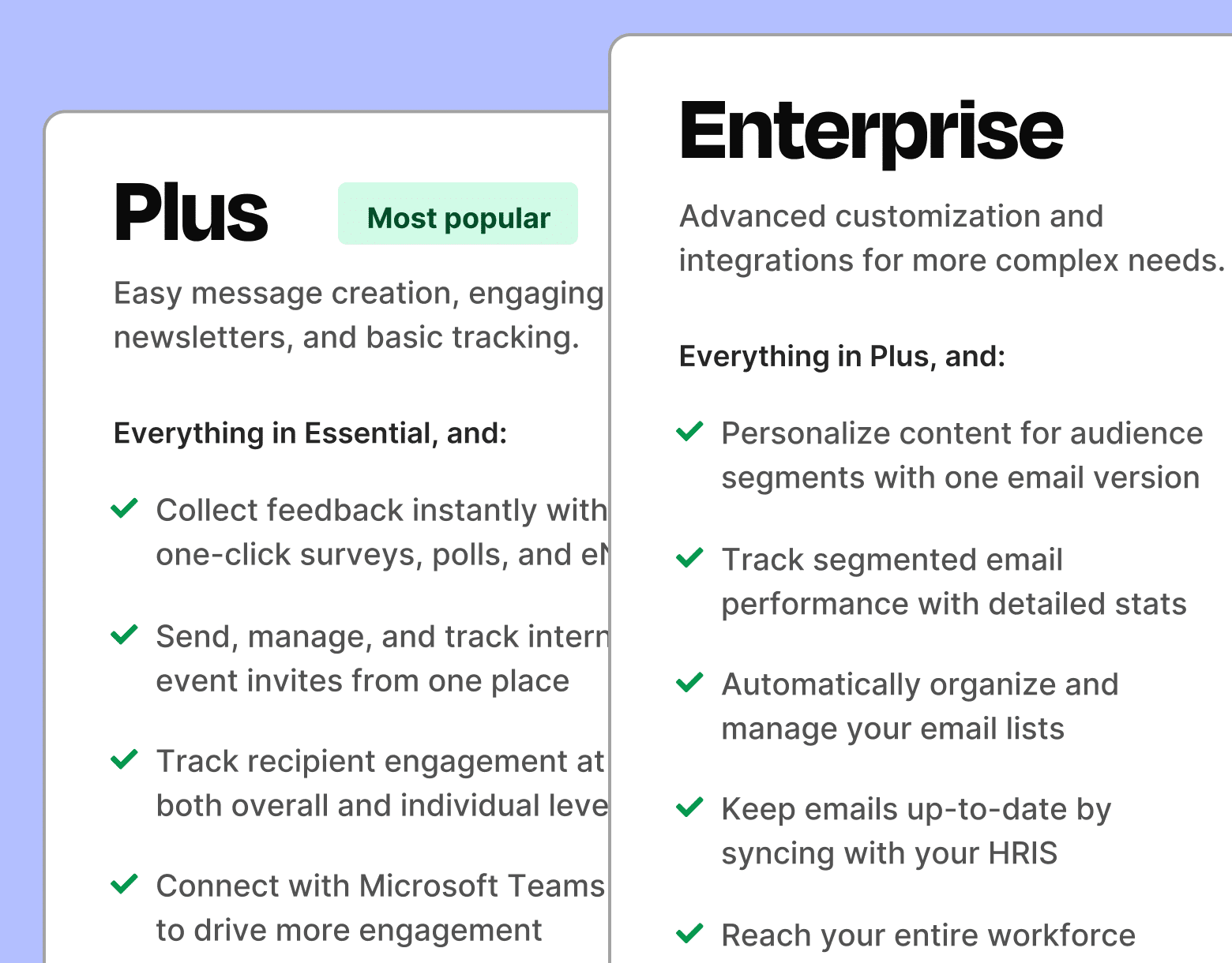Learning how to develop strategic internal communications is no easy feat. It requires you to take into consideration the needs and preferences of all stakeholders, be they employees or management.
It also involves understanding how both internal and external factors can affect communication effectiveness, as well as being aware of the appropriate channels and media for delivering messages. But the benefits of strategic internal communications are well worth the effort.
With the right approach in place, you can create a strong foundation for open dialogue and collaboration within your organization.
In this article, you will learn about the importance of effective internal communication, the components of an effective strategy, and how to measure success using internal comms tools.
Take a self-guided tour of ContactMonkey
See how our key features can streamline your internal communications.
Take product tour

What Is Strategic Internal Communications?
Strategic internal communication is the practice of creating and delivering messages to employees, managers, and other stakeholders in order to improve workplace productivity, morale, and engagement. It allows organizations to communicate their vision, mission, goals, and objectives more effectively.
The key objective of an effective internal communications strategy is to equip leaders with the information they need to make informed decisions that will help the organization meet its goals and objectives.
Benefits of strategic internal communications
Strategic internal communications can bring a number of benefits to any organization. It can increase employee engagement, morale, and productivity, as well as promote collaboration throughout the organization.
It also allows for better strategic alignment between departments and helps build trust among team members. Additionally, strategic internal communications can help organizations stay ahead of the competition and improve customer satisfaction.
Overall, strategic internal communications help ensure that everyone within the organization is on the same page and that messages are being communicated effectively.
Learn more about the many benefits to effective internal communication.
Pro Tip: Navigate multiple communication channels and never worry about IT restricting your internal employee lists. Use ContactMonkey’s HRIS integration.
Developing Strategic Internal Communications
Developing an effective internal communication strategy requires careful planning and consideration of the different elements that can affect its success.
It is important to identify the right internal communications channels for delivering messages. Consider your audience’s needs and wants, design a system that allows for two-way communication, create content tailored to various stakeholders, and measure results in order to track progress and make improvements.
Modern internal comms and measurement tools
No design or technical expertise needed. Save time, increase engagement, and dazzle your employees with fun and interactive communications.
Explore all features

By designing strategic internal communications that are tailored to the unique needs and goals of the organization, you can create a strong foundation for open dialogue, collaboration, and engagement within your organization. Check out our internal communication strategy checklist for a list of tactics you can adopt at your business, or our design thinking for internal communications blog.
Setting goals and objectives
The first step in any strategic internal communication is to establish clear internal communication goals and objectives. It’s important to identify what you want to achieve with your communication efforts so that you can focus on the right channels and tactics.
This may include increasing employee engagement, improving email collaboration between teams, promoting a company culture of transparency and trust, or simply making sure everyone within the organization is on the same page.
Picking the right goals and objectives will help you craft messages tailored to your target audience’s needs and interests and measure success more effectively.
Identifying stakeholders and audiences
The next step is to identify the stakeholders and audiences impacted by your internal communication activities. This includes employees, managers, executives, board members, customers, suppliers, and any other individuals or groups who may be affected by your messages.
It’s important to understand their needs and interests in order to tailor content and messages that will resonate with them. For example, executives may be interested in how your strategies will impact the organization’s overall performance, while employees may be more focused on their daily tasks and objectives. Sending the right message to the right audience is key to success.
Choosing the right channels for communication
You also need to identify the best channels for sharing your messages and delivering content. This may include email, newsletters, intranet, videos, webinars, or face-to-face meetings.
It’s important to consider the different needs of your stakeholders and audiences when choosing a communication channel in order to ensure that your messages are reaching the right people.
This can be a data-driven decision. For example, if you find that employees prefer to receive information through email newsletters, or if you see a higher open rate with those types of communications, then you’ll have to learn how to create an email newsletter to meet that need. The last thing you want is for your messages to be lost in the noise.
Creating a message plan
Once you have identified the goals and objectives for your internal communication, stakeholders, and chosen channels, it’s time to create a message plan.
Your message plan should include a timeline for the delivery of messages, clear actionable goals and objectives, content ideas and guidelines, KPIs for measuring progress, and strategies for engaging with your audiences.
Here’s an example of a message plan that you can use and adapt:
Timeframe: (how often will you be sending messages)
- We will send messages on a bi-weekly basis.
Goals and Objectives: (what do you want to achieve?)
- Our goal is to increase employee engagement by providing timely, relevant information and feedback.
Content Ideas: (what type of content will you be delivering?)
- We will provide content such as company updates, policy changes, employee recognition and appreciation, training materials, upcoming events, feedback surveys, and more.
KPIs for Measurement: (which metrics will you use to measure success?)
- We will track engagement metrics such as open rates, click-through rates, and response rates.
Engagement Strategies: (how will you engage with your audience?)
- We will engage with our audience through polls, surveys, and interactive content.
Even at a high level, this message plan provides clarity and direction for your internal communication and can help to keep everyone on the same page.
Unlock Internal Comms Superpowers
Discover why 10,000+ rely on us. See the internal email and employee newsletter platform in action.
Book demo

Determining metrics for successful measurement
Finally, it’s important to set metrics for measuring the success of your strategic internal communication. These should be tailored to your specific goals and objectives and may include metrics such as employee engagement, customer satisfaction, or overall morale.
Some of the most popular include Net Promoter Score (NPS) and Employee Net Promoter Score (eNPS), customer satisfaction surveys, and employee engagement surveys. Here are some quick examples of how you can use each of these metrics to make improvements over time:
- Employee Net Promoter Score: This metric measures how likely customers and employees are to recommend your company or organization to others. Tracking eNPS and NPS on a regular basis can help you identify trends in customer and employee satisfaction over time.
- Customer Satisfaction Surveys: These surveys provide valuable insight into customer needs and expectations, allowing you to make improvements to your products and services.
- Employee Engagement Surveys: Employee engagement surveys provide employers with important data about the job satisfaction of their employees, which can help identify areas for improvement.
Once you have identified the metrics that you will use to measure success, it’s time to start tracking them over time in order to gauge the effectiveness of your internal communication. With these metrics, you can make sure that your messages are resonating with your stakeholders and audiences, and make adjustments as needed in order to ensure the best possible results.
Crafting engaging content for internal communications
Now that you have developed your strategic internal communication, it’s time to start creating content. Content is key to engaging your audiences and making sure your messages are clearly communicated and understood.
When crafting your internal communications content strategy, consider the different needs of each stakeholder group and tailor the message accordingly. Make sure to use images and videos, and embed animated GIFs to keep your audience engaged. For example, if you’re trying to promote a new policy, use visuals or videos to help explain it.
Tools like ContactMonkey can help you create engaging emails and newsletters quickly and easily. With its drag-and-drop editor, you can create visually appealing messages without the need for coding or design experience. Access ready-to-use internal communication templates for every scenario, so you can quickly create messages that fit your brand and communicate your message effectively.
In addition to visuals, make sure to include a call to action in every message. This will encourage your audience to take action and engage with your content.
Implementing an internal communication plan
Once you’ve created your internal communications plan, it’s time to put the plan into action. Implementing your strategic internal communications can involve a variety of activities such as training, workshops, webinars, seminars, or even face-to-face meetings.
There are a few key things that you want to cover in these education trainings, including the purpose of the communication plan, how to use it effectively, and any guidelines or best practices. You might find it useful to include a healthy amount of question-and-answer time during these meetings in order to ensure everyone is on the same page.
Make sure to track progress throughout the process and refine your approach as needed. Regularly assess the effectiveness of your communication efforts in order to identify areas for improvement and adjust your approach accordingly.
The key here is to make sure that your internal communication plan is tailored to the specific needs of your organization and effectively meets the goals and objectives you set out from the beginning.


Managing Your Internal Communications Strategy
Once your internal communication plan is in place, it’s important to regularly evaluate and manage the strategy. This includes monitoring feedback from stakeholders, tracking metrics for success, assessing the effectiveness of content, and making changes as needed.
It’s also important to have a clear process for responding to feedback and addressing any issues that arise. By managing your strategic internal communications, you can ensure that it is achieving its intended objectives and delivering the desired results.
Reviewing feedback from employees and other stakeholders
Finally, it’s important to review employee feedback and feedback from other stakeholders in order to ensure that your strategic internal communications are effective.
This means regularly checking in with employees, conducting surveys, and assessing the impact of changes you have made. By taking into account feedback from different stakeholder groups, you can make sure that your strategic internal communications are meeting its goals and objectives.
For example, if employees are not understanding a new policy or procedure, then you can use the feedback to adjust your approach and create content that is more effective in communicating the changes.
By monitoring feedback regularly, you can ensure that your strategic internal communications are meeting its objectives and delivering positive results.
Adjusting your communications strategy as needed
As your organization evolves, so too should your internal communication plan. It’s important to assess the effectiveness of your strategy on a regular basis and adjust it as needed.
As an example, if your employees are not responding well to a certain type of communication, then you may want to consider changing the format or frequency. Or if your internal messaging is out-of-date and in need of an update, then it’s time to revamp your strategy.
It doesn’t have to be a complicated process to adjust your strategy. You can follow these simple steps:
- Take a step back and evaluate the current state of your internal communication plan.
- Identify areas of improvement or weaknesses in the strategy.
- Update content to ensure that it is relevant and accurate.
- Create new messages or formats that better engage with employees, such as videos or podcasts.
- Track progress and success metrics over time to ensure that the strategy is meeting its goals.
By regularly assessing the performance of your internal communication plan and making adjustments as needed, you can ensure that it is achieving its desired objectives and delivering the results your organization needs.
7 steps to a clear internal communications plan
The internal communicator’s bible to building a winning strategy.
Get the guide

Analyzing data to monitor progress on goals and objectives
Finally, it’s important to analyze data and metrics in order to monitor progress on your communication goals and objectives. Regularly review metrics such as employee engagement, customer satisfaction, or overall morale.
Use these metrics to track progress and make improvements over time. This will help whoever owns internal communications to ensure that your internal communication plan is always delivering the desired results and meeting its goals.
Having access to a centralized dashboard for internal communications can be a great way to monitor and review the performance of your strategy. With the right data, you can quickly identify areas for improvement and make the necessary adjustments.
Implement Your Strategic Internal Communications Plan With ContactMonkey
If you’re looking for an easy way to implement your strategic internal communications, ContactMonkey can help. The workforce communication platform offers a centralized analytics dashboard that allows you to manage, track and review the performance of your plan all in one place.
ContactMonkey also provides powerful tools like employee surveys, polls, engagement analytics, and more with its email template builder. With this solution, you can quickly identify areas for improvement and make the necessary adjustments to ensure that your internal communication plan is meeting its intended objectives.
So, if you’re looking for a comprehensive solution to manage and monitor your strategic internal communications, ContactMonkey can help. Get started today.


